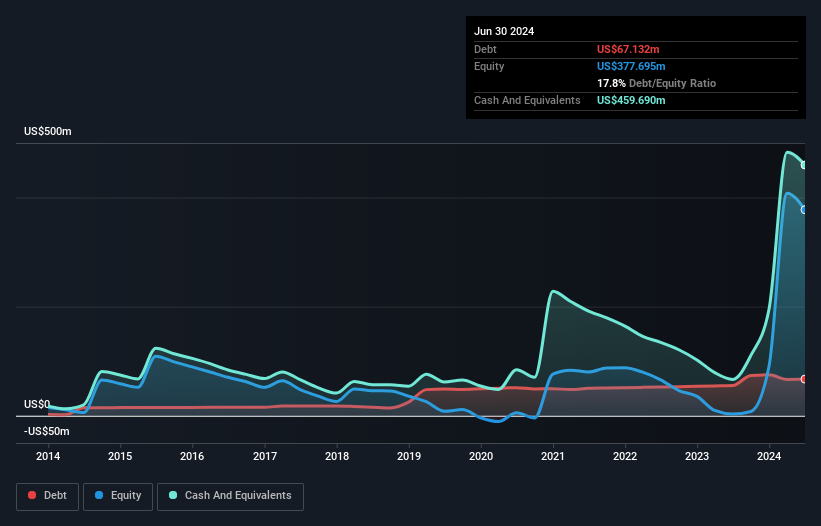
Warren Buffett famously said, 'Volatility is far from synonymous with risk.' When we think about how risky a company is, we always like to look at its use of debt, since debt overload can lead to ruin. Importantly, Ocular Therapeutix, Inc. (NASDAQ:OCUL) does carry debt. But the real question is whether this debt is making the company risky.
When Is Debt A Problem?
Debt and other liabilities become risky for a business when it cannot easily fulfill those obligations, either with free cash flow or by raising capital at an attractive price. Ultimately, if the company can't fulfill its legal obligations to repay debt, shareholders could walk away with nothing. However, a more frequent (but still costly) occurrence is where a company must issue shares at bargain-basement prices, permanently diluting shareholders, just to shore up its balance sheet. By replacing dilution, though, debt can be an extremely good tool for businesses that need capital to invest in growth at high rates of return. When we examine debt levels, we first consider both cash and debt levels, together.
Check out our latest analysis for Ocular Therapeutix
What Is Ocular Therapeutix's Net Debt?
You can click the graphic below for the historical numbers, but it shows that as of June 2024 Ocular Therapeutix had US$67.1m of debt, an increase on US$55.4m, over one year. However, its balance sheet shows it holds US$459.7m in cash, so it actually has US$392.6m net cash.

How Healthy Is Ocular Therapeutix's Balance Sheet?
The latest balance sheet data shows that Ocular Therapeutix had liabilities of US$30.0m due within a year, and liabilities of US$109.4m falling due after that. On the other hand, it had cash of US$459.7m and US$30.2m worth of receivables due within a year. So it can boast US$350.5m more liquid assets than total liabilities.
This surplus suggests that Ocular Therapeutix is using debt in a way that is appears to be both safe and conservative. Because it has plenty of assets, it is unlikely to have trouble with its lenders. Simply put, the fact that Ocular Therapeutix has more cash than debt is arguably a good indication that it can manage its debt safely. When analysing debt levels, the balance sheet is the obvious place to start. But it is future earnings, more than anything, that will determine Ocular Therapeutix's ability to maintain a healthy balance sheet going forward. So if you want to see what the professionals think, you might find this free report on analyst profit forecasts to be interesting.
Over 12 months, Ocular Therapeutix reported revenue of US$61m, which is a gain of 12%, although it did not report any earnings before interest and tax. We usually like to see faster growth from unprofitable companies, but each to their own.
So How Risky Is Ocular Therapeutix?
We have no doubt that loss making companies are, in general, riskier than profitable ones. And we do note that Ocular Therapeutix had an earnings before interest and tax (EBIT) loss, over the last year. And over the same period it saw negative free cash outflow of US$91m and booked a US$138m accounting loss. While this does make the company a bit risky, it's important to remember it has net cash of US$392.6m. That means it could keep spending at its current rate for more than two years. Even though its balance sheet seems sufficiently liquid, debt always makes us a little nervous if a company doesn't produce free cash flow regularly. There's no doubt that we learn most about debt from the balance sheet. However, not all investment risk resides within the balance sheet - far from it. For example Ocular Therapeutix has 3 warning signs (and 1 which shouldn't be ignored) we think you should know about.
If you're interested in investing in businesses that can grow profits without the burden of debt, then check out this free list of growing businesses that have net cash on the balance sheet.
New: AI Stock Screener & Alerts
Our new AI Stock Screener scans the market every day to uncover opportunities.
• Dividend Powerhouses (3%+ Yield)
• Undervalued Small Caps with Insider Buying
• High growth Tech and AI Companies
Or build your own from over 50 metrics.
Have feedback on this article? Concerned about the content? Get in touch with us directly. Alternatively, email editorial-team (at) simplywallst.com.
This article by Simply Wall St is general in nature. We provide commentary based on historical data and analyst forecasts only using an unbiased methodology and our articles are not intended to be financial advice. It does not constitute a recommendation to buy or sell any stock, and does not take account of your objectives, or your financial situation. We aim to bring you long-term focused analysis driven by fundamental data. Note that our analysis may not factor in the latest price-sensitive company announcements or qualitative material. Simply Wall St has no position in any stocks mentioned.
About NasdaqGM:OCUL
Ocular Therapeutix
A biopharmaceutical company, engages in the development and commercialization of therapies for retinal diseases and other eye conditions using its bioresorbable hydrogel-based formulation technology in the United States.
Flawless balance sheet and fair value.
Similar Companies
Market Insights
Community Narratives



